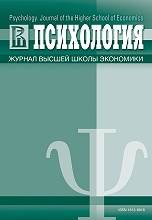Validation of the Russian-Language Version of the Ethics Position Questionnaire
Abstract
The results of validation of the Russian version of D. R. Forsyth’s Ethics Position Questionnaire (EPQ) are presented. The original version of the questionnaire contains two orthogonal factors (idealism and relativism) that form the basis of taxonomy of ethical positions (situationism, absolutism, subjectivism and exceptionism). The article suggests that idealism and relativism should be considered as behavioral dispositions. In this study, several theoretical models have been verified by means of confirmatory factor analysis. The CFA revealed that a two-level structural model where idealism and relativism are orthogonal second-order factors has the best fit. Idealism includes such factors as focus on reducing harm (I1) and concern for good (I2), and relativism includes such factors as relativity of ethic systems (R1), interpersonal relativism (R2) and veracity (R3). The received model has a number of advantages. First, it fully corresponds to the theoretical model of D. R. Forsyth, including the orthogonality of the main factors. Secondly, it assumes the multidimensionality of the constructs “idealism” and “relativism.” Thirdly, it allows to reconcile the results of previous empirical studies. The research established that the EPQ has good internal consistency, test-retest reliability, convergent, discriminant and nomological validity. The latter was evaluated within the nomological network in which idealism and relativism were correlated with constructs associated with the value system (within the Sh. Schwartz theory of basic values). The results make it possible to consider the Russian version of the EPQ as a reliable and valid instrument of assessment of idealism and relativism.
Downloads
References
2. Campbell, D. R., & Fiske, D. W. (1959). Convergent and discriminant validation by the multitraitmultimethod matrix. Psychological Bulletin, 56(2), 81-105.
3. Cui, C. C., Mitchell, V., Schlegelmilch, B. B., & Cornwell, B. (2005). Measuring consumers' ethical position in Austria, Britain, Brunei, Hong Kong, and USA. Journal of Business Ethics, 62(1), 57- 71. https://doi.org/10.1007/s10551-005-8501-7
4. Davis, M. A., Andersen, M. G., & Curtis, M. B. (2001). Measuring ethical ideology in business ethics: A critical analysis of the Ethics Position Questionnaire. Journal of Business Ethics, 32(1), 35-53. https://doi.org/10.1023/A:1010701417165
5. Douglas, P. C., & Wier, B. (2005). Cultural and ethical effects in budgeting systems: A comparison of U.S. and Chinese managers. Journal of Business Ethics, 60(2), 159-174. https://doi.org/10.1007/s10551-004-6711-z
6. Dunn, T. J., Baguley, T., & Brunsden, V. (2014). From alpha to omega: A practical solution to the pervasive problem of internal consistency estimation. British Journal of Psychology, 105(3), 399- 412. https://doi.org/10.1111 /bjop.12046
7. Eysenck, H. J., Barrett, P., Wilson, G., & Jackson, C. (1992). Primary trait measurement of the 21 components of the P-E-N system. European Journal of Psychological Assessment, 8(2), 109-117.
8. Fedorov, A. A. (2007). Stil' v psikhologii: dekonstruktsiia termina [Style in psychology: Deconstruction of the term]. Vestnik Novosibirskogo Gosudarstvennogo Universiteta. Seriya Psikhologiya, 1(1), 26-31. (in Russian)
9. Fornell, C., & Larcker, D. F. (1981). Evaluating structural equation models with unobservable variables and measurement error. Journal of Marketing Research, 18(1), 39-50. https://doi.org/10.2307/3151312
10. Forsyth, D. R. (1980). A taxonomy of ethical ideologies. Journal of Personality and Social Psychology, 39(1), 175-184. https://doi.org/10.1037/0022-3514.39.1. 175
11. Forsyth, D. R., O'Boyle, E. H., & McDaniel, M. A. (2008). East meets West: A meta-analytic investigation of cultural variations in idealism and relativism. Journal of Business Ethics, 83(4), 813-833. https://doi.org/10.1007/s10551-008-9667-6
12. Geldhof, G. J., Preacher, K. J., & Zyphur, M. J. (2014). Reliability estimation in a multilevel confirmatory factor analysis framework. Psychological Methods, 19(1), 72-91.
13. Hair, J. F., Black, W. C., Babin, B. J., & Anderson, R. E. (2014). Multivariate data analysis. Harlow, UK: Pearson Education Limited. Hermida, R. (2015). The problem of allowing correlated errors in structural equation modeling: concerns and considerations. Computational Methods in Social Sciences (CMSS), 3(1), 5-17.
14. Hu, L., & Bentler, P. M. (1999). Cutoff criteria for fit indexes in covariance structure analysis: Conventional criteria versus new alternatives. Structural Equation Modeling: A Multidisciplinary Journal, 6(1), 1-55. https://doi.org/10.1080/10705519909540118
15. Karande, K., Rao, C. P., & Singhapakdi, A. (2002). Moral philosophies of marketing managers: A comparison of American, Australian, and Malaysian cultures. European Journal of Marketing, 36(7/8), 768-791. https://doi.org/10.1108/03090560210430791
16. Khanin, Yu. L. (1976). Shkala Marlou-Krauna dlya issledovaniya motivatsii odobreniya. Metodicheskoe pis'mo [Marlowe-Crowne Social Desirability Scale]. Leningrad: NII fizicheskoi kul'tury. (in Russian)
17. Kornilova, T. V., Kornilov, S. A., Chumakova, M. A., & Talmach, M. S. (2015). The Dark Triad personality traits measure: approbation of the Dirty Dozen Questionnaire. Psikhologicheskii Zhurnal, 36(2), 99-112. (in Russian)
18. Kurtines, W. M. (1984). Moral behavior as rule-governed behavior: A psychosocial role-theoretical approach to moral behavior and development. In Morality, moral behavior, and moral development (pp. 149-194). New York: Wiley.
19. Lemeshko, B. Yu., & Lemeshko, S. B. (2008). Ob ustoichivosti i moshchnosti kriteriev proverki odnorodnosti srednikh [On the stability and power of criteria for checking the homogeneity of means]. Izmeritel'naia Tekhnika, 9, 23-28. (in Russian)
20. Marsh, H. W., Hau, K.-T., & Wen, Z. (2004). In search of Golden Rules: Comment on hypothesistesting approaches to setting cutoff values for fit indexes and dangers in overgeneralizing Hu and Bentler's (1999) findings. Structural Equation Modeling: A Multidisciplinary Journal, 11(3), 320- 341. https://doi.org/10.1207/s15328007sem1103_2
21. Norman, G. (2010). Likert scales, levels of measurement and the 'laws' of statistics. Advances in Health Sciences Education, 15(5), 625-632. https://doi.org/10.1007/s10459-010-9222-y
22. Paulhus, D. L. (1991). Measurement and control of response bias. In J. P. Robinson, P. R. Shaver, & L.S. Wrightsman (Eds.), Measures of social psychological attitudes (Vol. 1, pp. 17-59).
23. San Diego, CA: Academic Press. Pelaez, M. (2001). Morality as a system of rule-governed behavior and empathy. Behavioral Development Bulletin, 10(1), 8-14. https://doi.org/10.1037/h0100475
24. Redfern, K. (2004). An empirical investigation of the Ethics Position Questionnaire in the People's Republic of China. Journal of Business Ethics, 50(3), 199-210. https://doi.org/10.1023/B:BUSI.0000024741.85399.0d
25. Revelle, W., & Zinbarg, R. E. (2008). Coefficients Alpha, Beta, Omega, and the glb: Comments on Sijtsma. Psychometrika, 74(1), 145-154. https://doi.org/10.1007/s11336-008-9102-z





